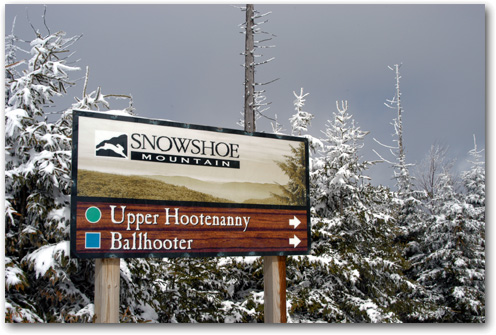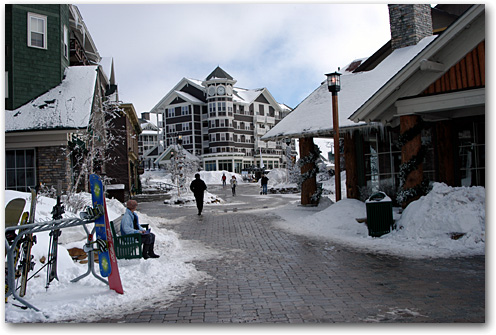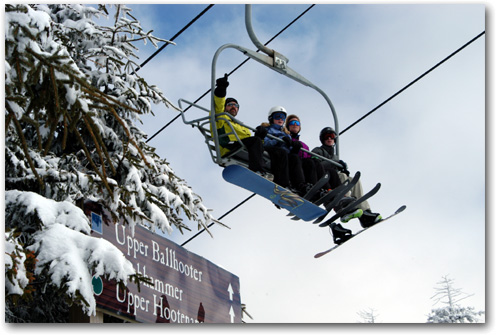
|
|
|
It’s mid-day on Thursday and a couple of snowflakes begin falling to the ground, at first tentatively, but then more aggressively. This is not a bad thing: I am en route to West Virginia’s Snowshoe Mountain Resort, and some fresh powder is always welcome at the beginning of a ski trip. Navigating the back-roads of Virginia and West Virginia, however, I am somewhat nervous: will the road conditions stay good?
My car’s navigation system had picked the route it felt would be quickest (and who am I to argue?), landing me squarely on 250, a road with so many mountain crossings and switchbacks that you’re never quite sure what direction you’re going. Not the best road in a snowstorm. And one far away from signs of civilization.
But I did quickly see one sign of civilization as I started climbing a steep grade: a snowplow (then, shortly, another one going in the opposite direction), clearing away snow as quickly as it fell while spreading gravel. This gravel was a lifesaver; it provided plenty of traction. Gravel would be my friend for the rest of the trip to Snowshoe. I drove carefully, knowing that a sudden application of the brakes would result in an unpleasant skid, but with careful driving I made it to Snowshoe during the storm without difficulty. Certainly, the states of Virginia and West Virginia do an admirable job keeping the roads (and backroads) clear.
A few switchbacks and miles past Cass, Snowshoe’s new access road beckoned me with a large sign. The recently-opened 2.5-mile road connects to the eastern side of the resort, opening up into the Top of the World parking lot and seconds away from the mountaintop Brigham Check-in Center. This road can shave 20-30 minutes off the trip to Snowshoe for visitors coming from the east, but some properties require check-in at the base of the mountain, so find out in advance where you need to check in before choosing to take the shortcut.
The new road also offers a second “escape route” from Snowshoe. In 1996, Cupp Run washed out Snowshoe’s main access road at the base of the mountain, which took 9 hours to clear. During that time, a medical emergency had to be evacuated in a snow groomer. The new road provides a second exit point from the resort. I’m told the road also offers great views, although the only view I saw was snowflakes falling, and that wasn’t such a bad view.
Normally it takes me about 6.5 hours to drive to Snowshoe, but the snow added an additional 1.5 hours to the drive. I checked into Rimfire Lodge, a relatively new facility at Snowshoe that helped launch Snowshoe’s new mountaintop village several years ago.

|
|
|
Rimfire Lodge offers condos in various sizes, with gas fireplaces, underground parking, fully equipped kitchens, and even free high-speed Internet access. The Internet access is a great bonus if you bring your own laptop; remember to bring an Ethernet cable if you plan to geek out after a day on the slopes. (But really, why bring a laptop when you’re at a ski resort? And yes, I realize I’m typing on a laptop right now at a ski resort. But I’m working, folks!)
Since Rimfire Lodge opened, Snowshoe has built additional slopeside accommodations, including Highland House and the recently-opened Allegheny Springs. A new lodging facility is also in the works. These properties anchor a pedestrian village, outfitted with a number of shops and restaurants. Here you can find t-shirts, chocolates, coffee, and lots of food options, just steps from the slopes.
Lodging options at Snowshoe range from upscale and expensive (e.g., Highland House) to economical (the Inn at Snowshoe, a motel found at the base of the mountain, or the slopeside but frugal Spruce Lodge). There are plenty of options in between, and most are found on the top of the mountain. Snowshoe is an “inverted resort”; you start your day by skiing down, and end the day by riding a lift to the top of the mountain.
It was too late to ski on Thursday, but not too late for dinner. For dinner, I headed to The Red Fox restaurant, which has been treating visitors to Snowshoe with culinary delights for many years. Fodor’s has rated The Red Fox as one of the nicest restaurants in the country, and the dinner (with eight separate courses) did not disappoint.
I, however, am not a food critic, and I claim no ability to accurately review menu items I cannot pronounce. The dinner included portions of smoked mountain trout, lobster bisque, rabbit, venison, and more. I’m a culinary wimp, and couldn’t bring myself to eat some of the items, such as the rabbit, but I devoured the mousseline du chocolat.
The Red Fox specializes in wild game, prime aged beef, and fresh seafood, creatively and artfully presented. Reservations are recommended, and plan on spending premium prices for a premium meal. This is not typical ski resort cafeteria fare.
By the time dinner was over, the snow had mostly stopped falling, leaving about 5 inches of powder ready and waiting for the next day’s skiing. Tired from a long day of driving and with a stomach full of food, I headed to bed.
The next morning, I grimaced as I realized the annoying sound I was hearing was the inconsiderate alarm clock. For a moment, I contemplated hitting the snooze. Then I remembered the fresh powder, and decided fresh powder was worth waking up for. After all, unlike the recent blizzard that dropped three feet of snow on my driveway, this was snow I didn’t have to shovel.
Although Snowshoe’s location delivers an abundance of snow each winter (nearly 200 inches this season so far), there is one downside: fog that is a common but unwelcome visitor at the higher elevations of the resort. On Friday morning, thick fog shrouded the mountain, reducing visibility to about 15 feet at the very top of the mountain, and hiding Snowshoe’s serene views. Halfway down the mountain, the fog began to clear, revealing the freshly groomed powder. After a run or two at the main basin area of Snowshoe, I headed over to the Western Territory, which requires a short hike across Snowshoe’s main road. (Or, in the case of heavy fog, a very careful short hike.) Snow conditions throughout the resort were in peak form.
The Western Territory, serviced by its own lift, offers only two trails, but they’re two good ones. Cupp Run and Shay’s Revenge, both black diamonds, drop 1,500 feet in 1.5 miles. (The Lower portion of Shay’s Revenge, offering a very steep pitch and moguls, gets a well-deserved double-black rating.) There is rarely a line at the Western Express lift, so it’s easy to wear your legs out quickly. The high-speed lift doesn’t leave much time to relax before delivering skiers and boarders back to the top of the mountain.

|
|
|
Lines can be a problem at the main Snowshoe basin area, however, with lots of skiers funneling to the bottom of the Ballhooter Express lift. By late morning on Friday, there was a line severate minutes long at the Ballhooter Express. On weekends, the line mazes can swell even more. Want to avoid lines on the weekends? Head to the nearby Silver Creek area (a short drive or shuttle ride away), which offers wider trails, a terrain park, a tubing hill, and lifts that are almost always devoid of lines. (However, there are no high-speed lifts at Silver Creek.)
I spent most of the morning in the Western Territory, and then stopped by the Foxfire Grill for lunch. Located in the Village at Snowshoe, the Foxfire Grill is operated by the same owners of The Red Fox - but while The Red Fox offers very serious meals, the Foxfire Grill is all about fun. Barbecue is the highlight at the Foxfire Grill, with lots of homemade sauces from tame to hot. And while some restaurants give you a pickle with your sandwich, the Foxfire Grill gives you a fried pickle. If you don’t want pulled pork, chicken, or hamburger, you can even get a fried bologna sandwich to go with your french fries and fried pickle. The owner has been known to make fried macaroni and cheese on occasion. But it’s not all about seeing how much can be fried; the food here is truly tasty, and the restaurant offers a great western view.
During lunch, this view began to actually materialize as the fog slowly lifted. By the end of lunch, one could see blue sky and sunshine, and this prompted me to go out and take a few pictures. (The fog would return by evening.)
M. Scott Smith is the founder and Editor of DCSki. Scott loves outdoor activities such as camping, hiking, kayaking, skiing, and mountain biking. He is an avid photographer and writer.